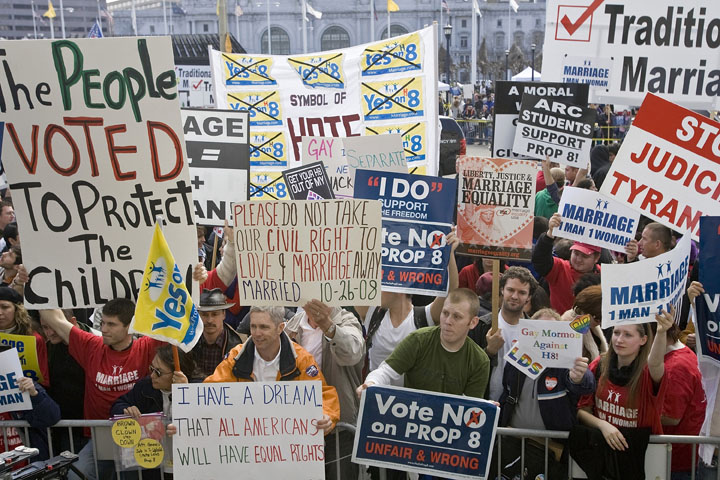Activities will help students:
- define unjust law and question why some inequities remain legal
- analyze photographs that show people confronting unjust laws
- recognize that photographs are not merely reflections of reality but mediated images that convey many meanings
- analyze the composition of photographs, including how photographers shape meaning by choosing how to crop images
- What is an unjust law?
- How do people protest such unjust laws?
- How do photographs show protests?
Introduction
Equality is one of the ideals on which the United States is based. Unfortunately, the country—and its laws—has not always lived up to that ideal. The tension was evident in the Constitution itself, when Northern and Southern states agreed to do nothing about slavery and to count each African American slave as 3/5 of a person for purposes of representation and taxation. Such injustices, are seen by many as unjust laws. Over the course of U.S. history, Americans have protested against such legal injustices in an effort to move the country toward fully embodying the ideals on which it was based.
Activities
1. (Note: Write “unjust law” on the board. Provide an explanation of the term. You may want to read the first paragraph of the introduction.) With a partner, restate in your own words the explanation of “unjust law.” Then brainstorm examples of such laws based on your knowledge of U.S. history.
2. What do you know about California’s Proposition 8? Read about it here. How might Proposition 8 be an example of an unjust law? After you have thought about the question, share your answer with a partner. Then report your responses to the class. (Note: Call on student pairs randomly.)
3. With this understanding of unjust laws and Proposition 8, look at photograph A.
Photograph A

Write answers to the following questions:
- Which poster caught your eye first? Why?
- What do you notice about the people in the photo? Do you notice any patterns regarding age, sex and race?
- When you look at the photograph as a whole, do you think it supports Proposition 8, opposes Proposition 8 or neither? How did you come to this conclusion?
Share your answers with your partner. Add any new insights you have gained in the conversation to your initial answers.
4. Photographers and their editors make decisions about how to crop photos before those photos go public. Cropping is “the act of cutting away unnecessary or unwanted portions of an image to help focus the viewers attention and help tell a story.” With your partner, take a piece of paper and try “cropping”—that is, redefining the edges of—the photograph different ways. How does each different way of defining the photo’s edges change your answers to the questions above? Be sure that one of the ways you crop the photo is only including a single person, rather than a group.
5. With your partner, find at least two photographs from a movement—past or present—against unjust laws. Try to find photographs that express different opinions about the protest—one that shows the protest in a sympathetic light and another that shows it in an unsympathetic light. Write captions for the photos. In the captions, explain what it is about the photograph that makes you think it either supports or opposes a particular view. Display photos around the classroom.
Caption for photograph A: San Francisco - March 5: People rally in front of the California Supreme Court Building after arguments were heard for and against Proposition 8 March 5, 2009 in San Francisco, California. The controversial proposition that prohibits gays and lesbians the right to marry is being challenged by the gay community. (Photo by David Paul Morris/ Getty Images)
Photograph B

1. Photograph B comes from an effort to combat another instance of what many see as an unjust law. In 2011, the Wisconsin legislature considered (and ultimately passed) a law that stripped state employees of their right to collective bargaining. In other words, the law limited employees’ rights. The right to bargain collectively was officially endorsed by the federal government in 1935, with passage of the Wagner Act, so the Wisconsin legislation led to large-scale protests in the state capital. You can read about the protests here.
With your partner, look at Photograph B, and answer these questions:
- How do you describe the person in the photo?
- Why do you think he is holding a skull?
- What is covering his mouth? Why do you think his mouth is covered that way?
- Does the photograph make you feel sympathetic to the person and his cause? Why or why not?
2. Try the cropping exercise again. How would cropping the photo in different ways change your feelings about the man and the injustice he is protesting? Since this photo is just of one person, imagine that this person is among the people in a group shot, similar to Photograph A. How would his placement in such a photo affect you as a viewer? Would it show the protests in a more positive light? A more negative light? Neither? Why do you think so?
Caption for photograph B: Shawn Petts, of Madison, Wis., carries a faux skull around the state Capitol in Madison, Wis., Thursday, Feb. 24, 2011, to protest the governor’s bill to eliminate collective bargaining rights for many state workers. Protesters are on their tenth day at the Capitol. (AP Photo/Andy Manis)
